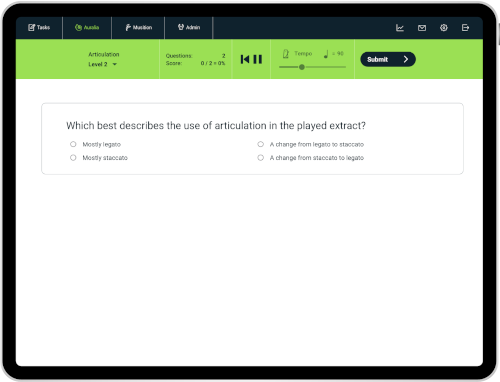Topics
Tune your ear with these fun topics
There are 59 topics in Auralia®, divided into seven groups: Rhythm, Intervals & Scales, Chords, Harmony & Form, Pitch & Melody, Repertoire and Musical Elements.
Auralia covers all your ear training needs with real audio and notation, linked to relevant curriculum.
Rhythm
Rhythm Dictation
Enter the rhythm on a score.
- Notes & rests up to 32nd notes
- 2/4, 3/4, 4/4, 5/4, 6/8, 7/8 etc
- Tuplets & syncopation
Meter Recognition
Identify the time signature of a rhythm or a melody.
Pulse Tapping
Tap back the rhythm played.
Rhythm Comparison
Identify alterations between two rhythms played.
Rhythm Elements
Identify the rhythm pattern played.
Two-Part Rhythmic Dictation
Enter the rhythms on a score, two parts!
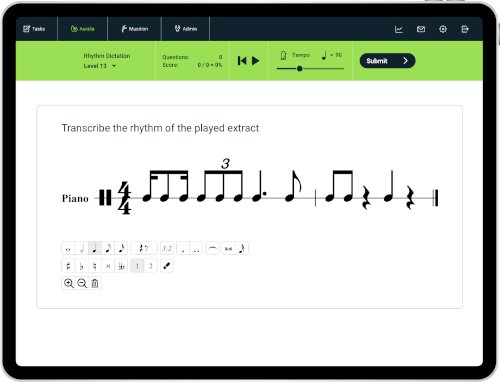
Rhythm Element Dictation
Identify the rhythm played using rhythmic blocks.
Rhythm Imitation
Tap back the rhythm played.
Rhythm Styles
Identify the style of the short musical excerpt.
Intervals & Scales
Scale Singing
Sing the notes of a certain scale shown on screen.
- Scales ascending and descending
- Modes ascending and descending
- Starting note within vocal range or fixed
Interval Comparison
Identify which interval is larger or smaller.
Interval Imitation
Sing the interval that is played or shown on screen.
Interval Recognition
Identify an interval using a piano keyboard or guitar fretboard.
Interval Singing
Sing the second note of a required interval shown on screen.
Jazz Scales
Identify jazz scales shown on screen using a piano keyboard or guitar fretboard.
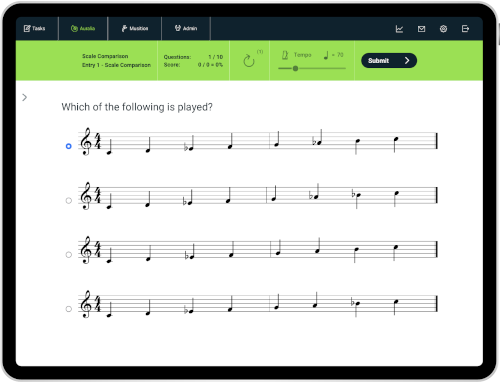
Jazz Scale Singing
Sing the notes of a certain jazz scale shown on screen.
Scales
Identify scales shown on screen using a piano keyboard or guitar fretboard.
Tonality
Listen to the extract and identify if it is major or minor.
Harmony & Form
Part Dictation
Transcribe the notes of a 4 part harmonic progression including basic chords and inversions.
- Transcribe single or multiple parts
- Chords I through VII
- 2/4, 3/4, 4/4, from 1 to 8 bars
Advanced Part Dictation
Transcribe the notes of a 4 part harmonic progression including chromatic and mixture chords.
Advanced Progressions
Identify the chord, quality & position of a 4 part
Chord Progressions
Identify the chord, quality & position of a 4 part harmonic progression.
Cadences
Identify the played cadences with or without a preceding melody.
Melodic Motion
Identify the melodic motion - similar. oblique, parallel or contrary.
Pop Chord Progressions
Identify the chord, quality & position of a pop harmonic progression.
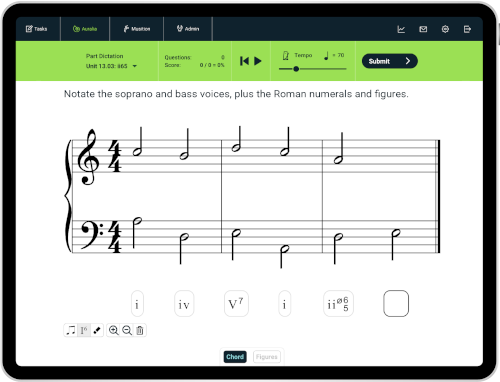
Forms
You are asked to identify the form of the melody.
Jazz Forms
You are asked to identify the form of the short piece played.
Jazz Progressions
Identify the progression played by entering the individual chords, or from multiple choice.
Modulation
Identify the type of modulation or the final key of the two part example played.
Pitch & Melody
Melodic Dictation
Enter the played melody on a score.
- Treble & Bass clef
- Lessons with notation & playback
- Ledger lines & accidentals
Absolute Pitch
Identify the exact notes that have been played, or the frequency (if waves are used). You may also be asked to sing back a given note, in a certain octave.
Atonal Melodic Dictation
Enter the played atonal melody on a score.
Contour
Identify the contour of the excerpt, monophone and homophonic excepts are used.
Counterpoint Singing
Sing the upper or lower notes of the short two part phrase played.
Melodic Comparison
Identify alterations between two melodies played.
Note Recognition
Sing the individual notes of a two or three note chord played.
Two Part Melodic Dictation
Enter the played melody on a score, two parts!
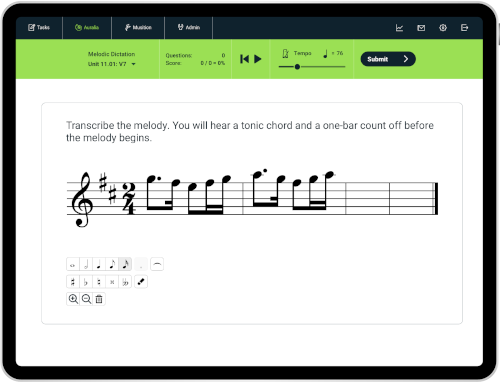
Pitch Comparison
Compare the pitch of two notes and identify if the second note is higher, lower or the same as the first.
Pitch Dictation
Identify the pitch of each note in a melody played by clicking the notes in on the staff or selecting the scale degree for each note.
Pitch Imitation
Sing back the note played.
Sight Singing
Sing back a melody using your microphone.
Tuning
Compare the two notes and identify if the second note is sharp, flat or in tune.
Repertoire
Work Identification
What is the name of the played piece?
Composer Identification
Who composed the played work?
Ensemble Identification
What type of ensemble played the work?
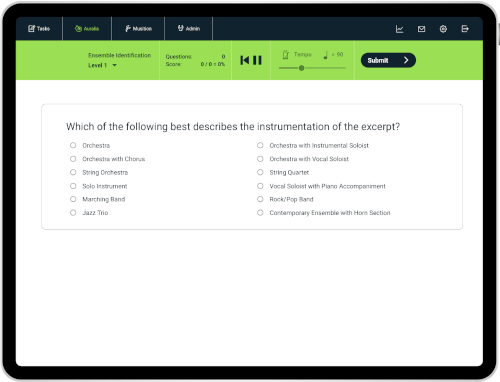
Musical Elements
Articulation
Recognise the type of articulation in a played extract.
Dynamics
Identify dynamics and changes in dynamics.
Tempo
Identify changes of tempo.
Texture & Density
Recognise the texture and changes in texture.
Compositional Devices
Identify the compositional device.
